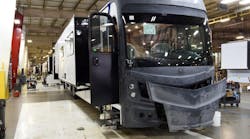How did 80% of the global RV production end up in Northeast Indiana?
As is the case in most manufacturing clusters, it all starts with a few people, an idea and a drive to be successful. In this case, it was three Hoosiers -- Milo Miller, Wilbur Schult and Harold Platt -- who according to Al Hesselbart, the former staff historian of the RV/MH Hall of Fame, “fell in love with trailers in the mid-1930s.”
Hesselbart explained, in an article in Inside Indiana Business, that by 1948 Elkhart had earned the title of “Trailer Capital of the World” as 100 companies were building trailers in and around Elkhart County.
Fast forward to 2017, where the tradition continues. Currently, Indiana ranks 3rd nationally in vehicle manufacturing with 20% of those in manufacturing working in this sector.
So the question is what factors were in place from then until now, that enabled this industry, as well as the entire vehicle industry to grow in this area.
John Sampson, CEO of the Northeast Indiana Regional Partnership has a few thoughts on this. “We have been making things for a long time and have a lot of expertise,” says Sampson. “But the secret to our success is our approach to manufacturing in that we are able to align workforce development with the business climate and the needs of the employers.”
Interesting, the RV industry has exemplified that strategy as it led the region to recovery after 2008. One of the companies instrumental in that momentum was REV Recreational Group. The company consolidated one its line in the region after 2009. Its manufacturing facilities for this line were scattered throughout the U.S. “We decided to consolidate in this region, even though we had just built a fairly new facility in a nearby state,” explains Lenny Razo, vice president of Marketing and Sales for REV Recreation Group.
“To me that says a great deal about what we thought about this region,” added Razo.
As one of the top employers, the company operates more than 4 million sq. ft. in Decatur, Elkhart and Bristol building brands such as American Coach, Monaco Coach, Holiday Rambler, Fleetwood RV and Renegrade RV.
When the company brought the additional manufacturing to this region they also brought in more technology and therefore had to train the workforce. They received help with workforce development by actions the county had made in 2006. That year, the county “took apart the system and undid the traditional approach to a demand-driven system,” said Sampson. “Early on we positioned workforce incentives for employers attached to targeted industries and the RV sector was part of that.”
As is always the story when talking about retaining and building a manufacturing cluster, the workforce is front and center.
In an area that has a well-established workforce, sometimes a different viewpoint is necessary. “We all realize that we are going to have to adapt to a new workforce,” explains Razo.
“We were having a lot of discussions about how the workdays would look as well as what benefits this group is looking at,” says Razo. For example, over the past few years, they have switched for four ten-hour days so employees have Friday off and can spend more time with their families. “In fact, we bring families into the facility and it’s neat to watch people show their families what they build.”
Keeping workers engaged in the manufacturing sector will be vital to this region that expects to create 26,000 new jobs over the next ten years. To address this continued growth, in an area that has very low unemployment, the county created a strategic plan, called Vision 2030. Part of that goal is to grow the area’s population to 1 million residents. A related goal is to have more than 60% of the workforce achieving a postsecondary credential. The county has already made some strides in this area through its Ivy Tech Community College system that provides dual credit opportunities to students in 35 high schools. Additionally, the region has eight STEM-focused New Tech schools. This training will go towards a tough situation that the area is facing in that it has more jobs in manufacturing then workers.
Yet business will still continue to expand given the robust supply chain for this cluster of manufacturing. An example is an announcement by Thor Motor Coach, this past July, that it will add more than 500,000 sq. ft. of manufacturing to its five Elkhart county campuses.
This type of growth is why area manufacturers have joined with each other as well as city agencies to plan for the future. “We are working with other manufacturers to continue to provide the strong workforce this area will continue to need,” says Razo.




